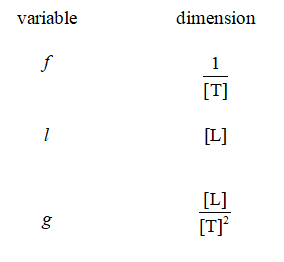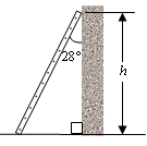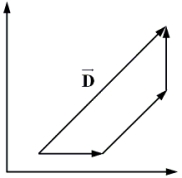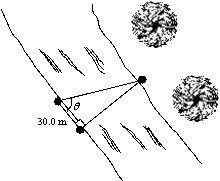A) 310
B) 720
C) 1200
D) 3100
E) 7200
Correct Answer

verified
Correct Answer
verified
Multiple Choice
The mass of a raindrop is 4 milligrams. Which one of the following statements indicates the correct mass of the raindrop in grams?
A) The raindrop has a mass of 4 × 106 grams.
B) The raindrop has a mass of 4 × 10-3 grams.
C) The raindrop has a mass of 4 × 10-1 grams.
D) The raindrop has a mass of 4 × 103 grams.
E) The raindrop has a mass of 4 × 10-6 grams.
Correct Answer

verified
Correct Answer
verified
Multiple Choice
Using the dimensions given for the variables in the table, determine which one of the following expressions is correct. 
A) ![]()
B) f = 2 gl
C) ![]()
D) ![]()
E) ![]()
Correct Answer

verified
Correct Answer
verified
Multiple Choice
Three vectors  ,
,  , and
, and  add together to yield zero:
add together to yield zero:  +
+  +
+  = 0. The vectors
= 0. The vectors  and
and  point in opposite directions and their magnitudes are related by the expression: A = 2C. Which one of the following conclusions is correct?
point in opposite directions and their magnitudes are related by the expression: A = 2C. Which one of the following conclusions is correct?
A) ![]() and
and ![]() have equal magnitudes and point in opposite directions.
have equal magnitudes and point in opposite directions.
B) ![]() and
and ![]() have equal magnitudes and point in the same direction.
have equal magnitudes and point in the same direction.
C) ![]() and
and ![]() have equal magnitudes and point in opposite directions.
have equal magnitudes and point in opposite directions.
D) ![]() and
and ![]() point in the same direction, but
point in the same direction, but ![]() has twice the magnitude of
has twice the magnitude of ![]() .
.
E) ![]() and
and ![]() point in the same direction, but
point in the same direction, but ![]() has twice the magnitude of
has twice the magnitude of ![]() .
.
Correct Answer

verified
Correct Answer
verified
Multiple Choice
Complete the following statement: Today, the standard meter is defined in terms of
A) the distance from the earth's equator to the north pole.
B) the wavelength of light emitted from a krypton atom.
C) the wavelength of light emitted from a sodium atom.
D) a platinum-iridium bar kept in France.
E) the speed of light.
Correct Answer

verified
Correct Answer
verified
Multiple Choice
Which one of the following quantities is a vector quantity?
A) the age of the earth
B) the mass of a freight train
C) the earth's pull on your body
D) the temperature of an iced coffee
E) the number of people attending a soccer game
Correct Answer

verified
Correct Answer
verified
Multiple Choice
During the execution of a play, a football player carries the ball for a distance of 33 m in the direction 58° north of east. To determine the number of meters gained on the play, find the northward component of the ball's displacement.
A) 8.0 m
B) 16 m
C) 24 m
D) 28 m
E) 32 m
Correct Answer

verified
Correct Answer
verified
Multiple Choice
A race car will make one lap around a circular track of radius R. When the car has traveled halfway around the track, what is the magnitude of the car's displacement from the starting point?
A) 2R
B) R
C) R
D) 2 R
E) zero meters
Correct Answer

verified
Correct Answer
verified
Multiple Choice
A 3.0-m ladder leans against a wall and makes an angle with the wall of 28° as shown in the drawing. What is the height h above the ground where the ladder makes contact with the wall? 
A) 2.6 m
B) 2.3 m
C) 2.1 m
D) 1.9 m
E) 1.6 m
Correct Answer

verified
Correct Answer
verified
Multiple Choice
The length of each side of a square is 4.0 m. What is the length of the diagonal of the square (shown as a dashed line in the figure) ? 
A) 2.8 m
B) 8.0 m
C) 5.7 m
D) 6.8 m
E) 16 m
Correct Answer

verified
Correct Answer
verified
Multiple Choice
Which one of the following is the longest length?
A) 100 meters
B) 102 centimeters
C) 104 millimeters
D) 105 micrometers
E) 107 nanometers
Correct Answer

verified
Correct Answer
verified
Multiple Choice
Which one of the following pairs of units may not be added together, even after the appropriate unit conversions have been made?
A) grams and milligrams
B) kilometers and kilograms
C) miles and kilometers
D) slugs and kilograms
E) centimeters and yards
Correct Answer

verified
Correct Answer
verified
Multiple Choice
Complete the following statement: Today, the standard unit of time is defined in terms of
A) the electromagnetic waves emitted by cesium atoms.
B) the motion of the moon around the earth.
C) the motion of a precision pendulum.
D) the average solar day.
E) the speed of light.
Correct Answer

verified
Correct Answer
verified
Multiple Choice
Two vectors  and
and  are added together to form a vector
are added together to form a vector  . The relationship between the magnitudes of the vectors is given by: A2 + B2 = C2. Which statement concerning these vectors is true?
. The relationship between the magnitudes of the vectors is given by: A2 + B2 = C2. Which statement concerning these vectors is true?
A) ![]() and
and ![]() must be at right angles to each other.
must be at right angles to each other.
B) ![]() and
and ![]() could have any orientation relative to each other.
could have any orientation relative to each other.
C) ![]() and
and ![]() must have equal lengths.
must have equal lengths.
D) ![]() and
and ![]() must be parallel.
must be parallel.
E) ![]() and
and ![]() could be antiparallel.
could be antiparallel.
Correct Answer

verified
Correct Answer
verified
Multiple Choice
Which one of the following is an SI base unit?
A) gram
B) slug
C) newton
D) centimeter
E) kilogram
Correct Answer

verified
Correct Answer
verified
Multiple Choice
Three sticks are arranged to form a right triangle. If the lengths of the three sticks are 0.47 m, 0.62 m and 0.78 m, what are the three angles of the triangle?
A) 90°, 45°, and 45°
B) 90°, 62°, and 28°
C) 90°, 59°, and 31°
D) 90°, 48°, and 42°
E) 90°, 53°, and 37°
Correct Answer

verified
Correct Answer
verified
Multiple Choice
The distance d that a certain particle moves may be calculated from the expression d = at + bt2 where a and b are constants; and t is the elapsed time. What must the dimensions of the quantities a and b be, respectively?
A) ![]()
B) [L], [L]2
C) ![]()
D) ![]()
E) ![]()
Correct Answer

verified
Correct Answer
verified
Multiple Choice
Three vectors  ,
,  , and
, and  have the following x and y components: Ax = 1 m, Ay = 0 m, Bx = 1 m, By = 1 m, Cx = 0 m, Cy = -1 m
According to the graph, how are
have the following x and y components: Ax = 1 m, Ay = 0 m, Bx = 1 m, By = 1 m, Cx = 0 m, Cy = -1 m
According to the graph, how are  ,
,  , and
, and  combined to result in the vector
combined to result in the vector  ?
? 
A) ![]() =
= ![]() -
- ![]() -
- ![]()
B) ![]() =
= ![]() -
- ![]() +
+ ![]()
C) ![]() =
= ![]() +
+ ![]() -
- ![]()
D) ![]() =
= ![]() +
+ ![]() +
+ ![]()
E) ![]() = -
= - ![]() +
+ ![]() +
+ ![]()
Correct Answer

verified
Correct Answer
verified
Multiple Choice
A surveyor wants to find the distance across a river. A stake is placed on each bank of the river as shown in the figure. She measures a distance of 30.0 m from one stake to another on the same side of the river, thus finding the third vertex on a right triangle. She then measures the angle and finds it equal to 75.9°. What is the distance across the river? 
A) 89.2 m
B) 15.3 m
C) 119 m
D) 268 m
E) 29.0 m
Correct Answer

verified
Correct Answer
verified
Multiple Choice
Which one of the following choices is equivalent to 44.5 mm?
A) 4.45 × 101 m
B) 4.45 × 10-2 m
C) 44.5 × 10-1 m
D) 44.5 × 10-2 m
E) 4.45 × 100 m
Correct Answer

verified
Correct Answer
verified
Showing 21 - 40 of 70
Related Exams